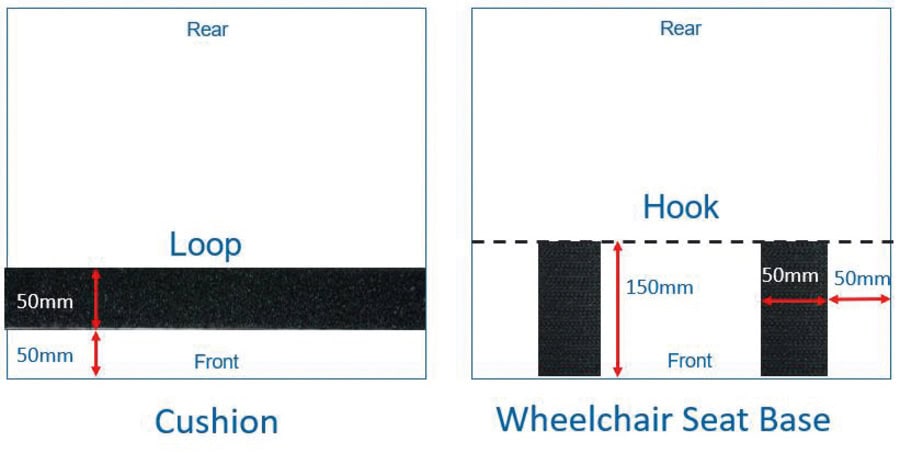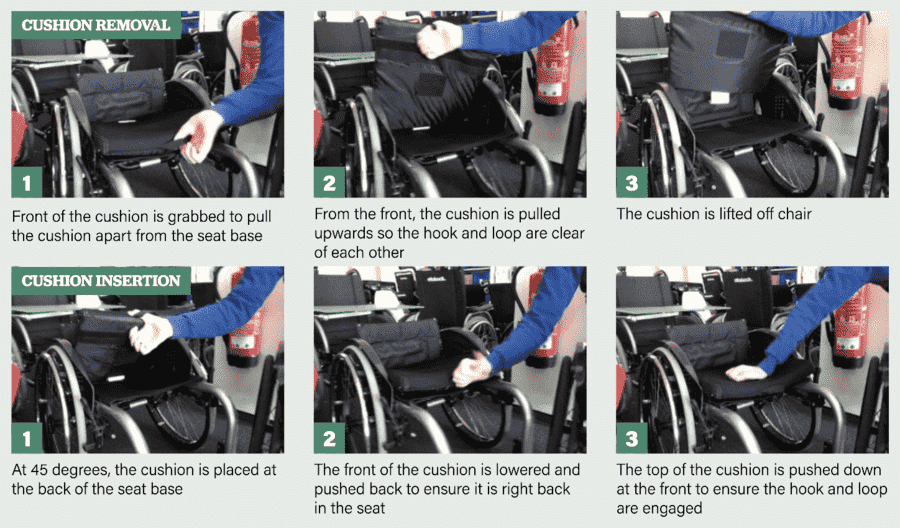Let’s Get It Clear: Does my cushion match my chair?

It’s really important that a wheelchair cushion stays in place in the chair during use, in order to prevent slipping off the wheelchair canvas or seat base, manufacturers provide hook and loop attachments sewn under the cushion cover and attached to the wheelchair seat base. However, there is no consistency as to where either the hook or the loop are placed, and so no guarantee that they will interact with each other and actually prevent the cushion from slipping. This has now been addressed in the new international standard ISO/TS 16840-15:20241.
There is little standardisation around fastenings in wheelchair seating, and thus it’s simply potluck as to whether the nuts, bolts, etc in one’s toolkit will be compatible with the system one’s trying to work on!
Some years ago, an idea was floated to create a standard to provide guidance for manufacturers as to what to aim for when prescribing screws, nuts, bolts, washers, rivets, grommets, axle shafts dimensions etc. A start at least would be if all manufacturers around the world were to use metric fastenings! This ideal has not gained much traction, as yet, since each designer working in isolation tends to select the best tool from what is at hand at that moment, to achieve their immediate end. The resultant solution worked in that situation – but the potential impact on inventories around the world when that design goes into production, and indeed potential customer confusion is significant.
Hook and loop fasteners
One area of fastening which did make some progress was that of hook and loop fasteners. There are three aspects that need to be considered – first, the physical characteristics of the fasteners; second, the attachment method for the hook and loops; and, third, where they are to be placed on both the item to be fastened, and on the item to which they are to be fastened.
There are published standards for measuring both how well the fasteners stand up to sliding (shear) forces on the one hand, and to the peelability or separability of the loop from the hook, or v.v., on the other. These parameters have practical implications in use: too sticky and you’ll not be able to take a cushion from its seat base, while not sticky enough and the cushion will slip out of position. There are no agreed ideal ranges of forces for either of these aspects as yet.
Fastening the hook or loop to a cushion cover lower surface is probably most effective by sewing it onto the item – if possible. If an adhesive is used, either on a cushion cover or seat base, the adhesive has to be stronger than the sliding or peeling forces described above. Whichever application method is selected, consideration needs to be made not only of the effects of shear forces, but also of temperature or moisture on the adequacy and longevity of the method.
Where to place the hook and where to place the loop?
If you inspect the underside of the commercially available cushions in the wheelchair cushion marketplace you will find that almost every manufacturer has chosen a different solution. Some will have chosen 25mm wide strips, while others have chosen 38 or 50 mm wide strips, or even a combination of these. Some strips are lined up left to right across the cushion and some from front to back. Some manufacturers have gone for squares instead of strips. Some are hook and some are loop. See Figure 1
Likewise, if you inspect the seating bases of different wheelchairs on the market, you will also find the same variety of options of hook vs loop, of widths, and of direction of strips. See Figure 2. In some instances, even where the manufacturer has supplied both the chair and the cushion, the two are still not compatible with each other!
This is all crying out for standardisation, and this is now at hand with the recommendations in Annex F of ISO/TS 16840-15:20241, which has just been published.
What would be ideal for a user?
In research behind the recommendations in this standard, Kim Chaney, an OT with many years’ experience in the prescription and provision of wheelchair seating, carried out a study into how a wheelchair occupant with limited hand function removed and replaced their cushion, to give guidance as to where the hook and loop would be a help and where it would be a hindrance.
The conclusion was that hook and loop at the front of the cushion and seat base aided, while at the rear of a cushion or seat base impeded, one-handed removal or insertion of the cushion.
Resultant recommendations
- The Loop (rather than Hook, so that when the cover is in the wash, it does not catch on other items) to be attached to the base of the cushion cover running left to right.
- The Loop to be placed the full width of the cushion and near the front.
- The Hook be applied to the wheelchair seat base running back to front, so that it will always be at right angles to the loop.
- The Hook to be placed near the front of the base so that it will always be engaged with the Loop at the front of the cushion.
- Where fitted to a width adjustable seat base, the Hook should be fitted in the narrowest configuration.
- 50 mm width Hook and Loop are recommended. For chairs less than 340 mm wide, 25mm Hook and Loop can be used.
ISO/TS 16840-15:2024 Wheelchair seating — Part 15: Selection, placement and fixation of flexible postural support devices in seating
Further items can be found at www.beshealthcare.net. If you are interested in receiving further information on the topic, please contact 
Dr Barend ter Haar has been involved in seating and mobility for over 30 years, including lecturing internationally and developing international seating standards





